Related Research Articles

The Office of Strategic Services (OSS) was the intelligence agency of the United States during World War II. The OSS was formed as an agency of the Joint Chiefs of Staff (JCS) to coordinate espionage activities behind enemy lines for all branches of the United States Armed Forces. Other OSS functions included the use of propaganda, subversion, and post-war planning.
Secret police are intelligence, security or police agencies that engage in covert operations against a government's political, religious, or social opponents and dissidents. Secret police organizations are characteristic of authoritarian and totalitarian regimes. They protect the political power of a dictator or regime, and often operate outside the law to repress dissidents and weaken political opposition, frequently using violence.

Counterintelligence is an activity aimed at protecting an agency's intelligence program from an opposition's intelligence service. It includes gathering information and conducting activities to prevent espionage, sabotage, assassinations or other intelligence activities conducted by, for, or on behalf of foreign powers, organizations or persons.
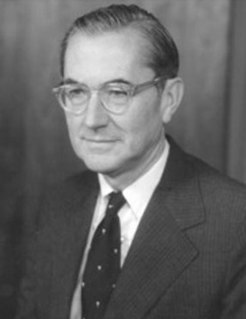
William Egan Colby was an American intelligence officer who served as Director of Central Intelligence (DCI) from September 1973 to January 1976.
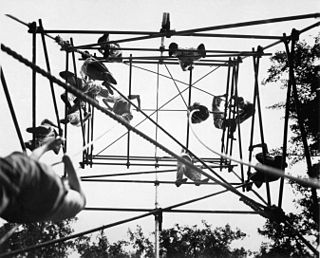
Operation Jedburgh was a clandestine operation during World War II in which three-man teams of operatives of the British Special Operations Executive (SOE), the U.S. Office of Strategic Services (OSS), the Free French Bureau Central de Renseignements et d'Action and the Dutch and Belgian armies in exile were dropped by parachute into occupied France, the Netherlands and Belgium. The objective of the Jedburgh teams was to assist allied forces who invaded France on 6 June 1944 with sabotage and guerrilla warfare, and leading local resistance forces in actions against the Germans.
Intelligence assessment, or simply intel, is the development of behavior forecasts or recommended courses of action to the leadership of an organisation, based on wide ranges of available overt and covert information (intelligence). Assessments develop in response to leadership declaration requirements to inform decision-making. Assessment may be executed on behalf of a state, military or commercial organisation with ranges of information sources available to each.

Sir William Samuel Stephenson, born William Samuel Clouston Stanger, was a Canadian soldier, fighter pilot, businessman and spymaster who served as the senior representative of the British Security Coordination (BSC) for the western allies during World War II. He is best known by his wartime intelligence codename, Intrepid. Many people consider him to be one of the real-life inspirations for James Bond. Ian Fleming himself once wrote, "James Bond is a highly romanticised version of a true spy. The real thing is... William Stephenson."
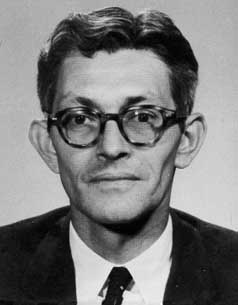
James Jesus Angleton was chief of counterintelligence for the Central Intelligence Agency (CIA) from 1954 to 1974. His official position within the organization was Associate Deputy Director of Operations for Counterintelligence (ADDOCI). Angleton was significantly involved in the US response to the purported KGB defectors Anatoliy Golitsyn and Yuri Nosenko. Angleton later became convinced the CIA harbored a high-ranking mole, and engaged in an intensive search. Whether this was a highly destructive witch hunt or appropriate caution vindicated by later moles remains a subject of intense historical debate.

William Harding Jackson was a U.S. civilian administrator, New York lawyer, and investment banker who served as Deputy Director of the Central Intelligence Agency. Jackson also served briefly under President Dwight D. Eisenhower as Acting United States National Security Advisor from 1956 to 1957.

The Sedgley OSS .38 glove pistol or Sedgley Fist Gun is a World War II firearm. It was designed by Stanley M. Haight and manufactured by Sedgley Co. of Philadelphia for the U.S. Marines and the U.S. Navy. Its official designation by the US Navy was Hand Firing Mechanism, Mk 2.

The National Intelligence Coordinating Agency (NICA) is the primary intelligence gathering and analysis arm of the Philippine government, in charge of carrying out overt, covert, and clandestine intelligence programs. The NICA cooperates with friendly countries and government agencies in and out of the country by posting agents as liaison officers.
The History of the Counter Intelligence Corps was a classified 30 volume book prepared in the late 1950s by Major Ann Bray and others at the United States Army Intelligence Center and printed in 1959. The document contains the history of the US Army's Counter Intelligence Corps (CIC) until 1950. A declassified (sanitized) version of the official history is now available to researchers at the National Archives and Records Administration (NARA).

The Counter Intelligence Corps was a World War II and early Cold War intelligence agency within the United States Army consisting of highly trained special agents. Its role was taken over by the U.S. Army Intelligence Corps in 1961 and, in 1967, by the United States Army Intelligence Agency. Its functions are now performed by its modern-day descendant organization; United States Army Counterintelligence. The National Counter Intelligence Corps Association (NCICA), a veterans' association, was established in the years immediately following World War II by Military Intelligence agents who had served in every area of military and domestic operations. The organization meets annually. Its newsletter, the Golden Sphinx, is published quarterly.
Telephone tapping in the countries of the Eastern Bloc was a widespread method of the mass surveillance of the population by the secret police.
National governments deal in both intelligence and military special operations functions that either should be completely secret, or simply cannot be linked to the sponsor. It is a continuing and unsolved question for governments whether clandestine intelligence collection and covert action should be under the same agency. The arguments for doing so include having centralized functions for monitoring covert action and clandestine HUMINT and making sure they do not conflict, as well as avoiding duplication in common services such as cover identity support, counterespionage, and secret communications. The arguments against doing so suggest that the management of the two activities takes a quite different mindset and skills, in part because clandestine collection almost always is on a slower timeline than covert action.
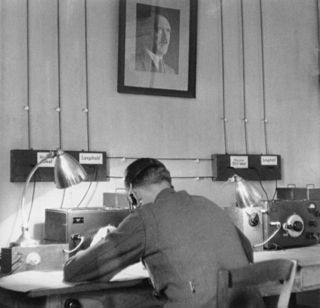
The Abwehr was the German military-intelligence service for the Reichswehr and the Wehrmacht from 1920 to 1944. Although the 1919 Treaty of Versailles prohibited the Weimar Republic from establishing an intelligence organization of their own, they formed an espionage group in 1920 within the Ministry of Defence, calling it the Abwehr. The initial purpose of the Abwehr was defence against foreign espionage: an organizational role which later evolved considerably. Under General Kurt von Schleicher the individual military services' intelligence units were combined and, in 1929, centralized under Schleicher's Ministeramt within the Ministry of Defence, forming the foundation for the more commonly understood manifestation of the Abwehr.
The head of the Office of Strategic Services (OSS), William Donovan, created the X-2 Counter Espionage Branch in 1943 to provide liaison with and assist the British in its exploitation of the Ultra program's intelligence during World War II. A few months before, Donovan had established a Counterintelligence Division within the Secret Intelligence Branch of the OSS but rescinded this order upon development of the X-2. The X-2 was led by James Murphy, whose branch would have the power to veto operations of the Special Operations and Secret Intelligence Branches without explanation. Donovan modeled the Counter Espionage Branch on British Counter Espionage. With the creation of the X-2 Branch, the British insisted that it follow British security procedures to maintain the secrecy of Ultra. The X-2 established separate lines of communication for itself as a self-contained unit. By the end of World War II, the X-2 had discovered around 3,000 Axis agents.

Spying, as well as other intelligence assessment, has existed since ancient times. In the 1980s scholars characterized foreign intelligence as "the missing dimension" of historical scholarship." Since then a largely popular and scholarly literature has emerged. Special attention has been paid to World War II, as well as the Cold War era (1947–1989) that was a favorite for novelists and filmmakers.
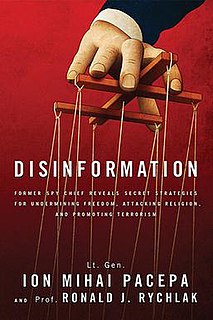
Disinformation: Former Spy Chief Reveals Secret Strategies for Undermining Freedom, Attacking Religion, and Promoting Terrorism is a 2015 non-fiction book about disinformation tactics and history rooted in information warfare. It was written by former general in the Securitate, the secret police of Socialist Republic of Romania, Ion Mihai Pacepa, and law professor Ronald J. Rychlak. It was published in 2013 along with a companion film, Disinformation: The Secret Strategy to Destroy the West.

Dezinformatsia: Active Measures in Soviet Strategy is a non-fiction book about disinformation and information warfare used by the KGB during the Soviet Union period, as part of their active measures tactics. The book was co-authored by Richard H. Shultz, professor of international politics at Tufts University, and Roy Godson, professor emeritus of government at Georgetown University.
References
- GVK - Common Union Catalogue
- Mendelsohn, John (1989). Covert Warfare: Intelligence, Counterintelligence and Military Deception During the World War II Era. New York City: Garland.